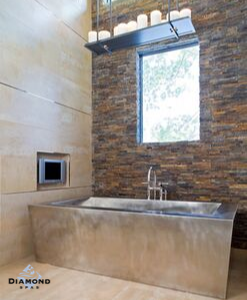Bathrooms have quickly become the gee-whiz spaces of tomorrow. Not because they’re filled with gadgets and gizmos to delight the inner-techie in you, but because they are taking cleanliness and functionality to new levels.
The demand is soaring in homes for bathrooms that offer touch-free fixtures, spa-like appointments with custom soaking tubs and the ability to allow your personal devices to follow you seamlessly from other parts of the house into the inner sanctum of privacy.
“We’re seeing so much more technology enter the space,” says Travis Rotelli, senior interior designer for Wisconsin-based Kohler. “People want the ability to customize their experience and to be more involved with the products in the bathroom.”
“Gen Y has grown up with technology,” says John Petrie, president-elect of the 60,000-member National Kitchen & Bath Association. “They’re accustomed to having it. Now, they are in the situation where they’re buying homes — and that’s what they expect.”
“They’re not talking about toys,” says David Krakoff, president of sales for the Americas at TOTO USA. He views the products his company makes for the bathroom as essential, not just high-tech. “We’re addressing people’s legitimate need to get clean, to improve their experience in the bathroom.” They want products more in tune with the 21st century than the 18th century, he says.
And Generation Y is not alone. The desire for bathrooms to be more efficient and welcoming of personal technology cuts across all generations and demographics as consumers become increasingly wedded to their touch-screen devices and the ease of use they’ve come to expect in products.
In fact, a survey last year by integrated marketing firm 11mark, based in Alexandria, Va., found that 75% of Americans use their phones to text, e-mail and — in some cases — talk while in the bathroom.
They want the technology to be present but largely invisible in the bathroom, says David Lingafelter, president of Moen, which is based in North Olmsted, Ohio. “You’re starting to see the integration more of the digital technology that you can preprogram, that you can preset. Who wants the spinning dial anymore?”
The average bathroom remodeling project cost about $10,760 in 2011, according to the latest full-year figures available from the Joint Center for Housing Studies of Harvard University (JCHS). However, the average return on investment is only about 62% to 65%, Petrie estimates. That’s only slightly higher than in past years. Yet homeowners are often willing to take the plunge on a luxury bathroom project because what they gain in the ability to customize and personalize their time in the bathroom can’t always be measured in dollars and cents.
The push for better products in the bathroom is driven in large part by the cautious optimism bubbling in the housing industry as home price decline and foreclosures and tight credit spawned by the recession recede. In 2011, spending on home improvements and repairs climbed to $275 billion, says JCHS research analyst Abbe Will.”For 2013, we’re projecting strong year-over-year growth increasing through the third quarter,” she says. While it will likely fall far short of the market peak of $328 billion in 2007, the increases indicate a growing boldness among consumers.
“We are starting to see the momentum coming back into the market with people investing in their homes again,” Lingafelter says. And though consumers are not spending with reckless abandon, they are exploring new options for their homes “carefully, cautiously and deliberately,” he says.
He says consumers’ desire for bathroom solutions that address their demand for more personalization coincides with the popularity of home improvement TV shows such as those on cable network HGTV. Homeowners are more aware of the options they can put into their homes. People want to integrate thoughtful design into their “digital dwellings,” Lingafelter says. They don’t just want technology for technology’s sake.
And to do that, they are willing to forgo the McMansions of the past, he adds, if they can get more customization into a smaller footprint. “They’re looking at the life payback from the stuff they want to spend their money on.”

